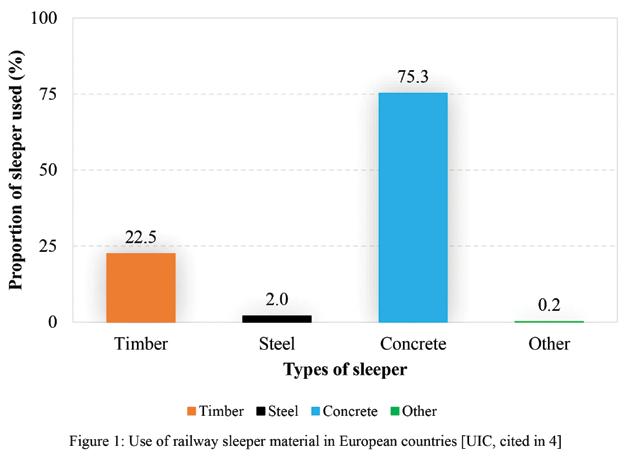
8 minute read
Case Study: Concrete Fibres Railway Sleepers
by Associate Professor Olivia Mirza
Advertisement
Nowadays, Australia’s population is over 25 million having increased by almost five times over the last century. As such, huge planning and investment are being made in the infrastructure to further overcome congestion and capacity issues. Accordingly, the railway connectivity will be an important factor towards the integration of regional and metropolitan economies for their mutual benefit.
By 2075, the population is forecast to double putting huge constraints on the railway network which will be required to keep pace with such growing demand. For instance, by 2026 there is already a forecast growth of 19% and 26% in the passenger and freight operations respectively [1]. Therefore, increasingly railway operational conditions characterise faster average speeds and frequency of services requiring the Australian railway infrastructure to be properly maintained towards ensuring the safety, reliability and efficiency in connecting regions and cities.
One solution to this challenging task was to assess essential track components to ensure they could satisfy the line upgrades. According to researchers [2, 3], one of the critical track components is the sleeper which main function is to maintain the track gauge and redistribute the axle loads to the ballast.
Typically, railway sleepers are made from timber, steel and prestressed concrete despite recent concerns associated to the degradation, durability and high-cost of such conventional materials. For instance, wooden sleepers offer a comparatively cheap, lightweight and easy to install option despite being far more prone to wear and tear particularly with the shortage of highquality timber.
On the other hand, steel sleepers were often seen as a middle ground between
the wooden and concrete alternatives, offering better load-bearing capacities with reduced dependence on the ballast bed. However, steel sleeper implementation remained fairly limited due to major drawbacks such as susceptibility to corrode and fatigue cracking at the rail seat.
In comparison, the modern prestressed concrete sleeper embodies superior load capacity, track stability and a longer service life requiring on average less maintenance. Other concerns related to the sleeper’s material have long been acknowledged, resulting in premature failure of conventional sleepers and their associated replacement cost incurred as shown in Figure 2. In other words, prestressed concrete sleeper is being the preferred option nowadays despite timber historically dominating as a railway sleeper material.
The most modern development in the field of railway sleeper highlights the benefits of composites sleeper being made from a combination of plastic, recycled rubber, and fibreglass. These are indeed engineered to possess adequate strength, damping and environmentally friendly characteristics to reduce the disposal cost. Nevertheless, the practical implementation of such sleepers remained fairly limited due to their unknown long-term behaviour and high manufacturing cost.
As a result, the idea was to implement new fibre technologies into the well-known and already mass-produced prestressed concrete sleeper to enhance its structural performances, reduce weight and overall cost while also being more sustainable. This innovative research is a collaboration between School of Engineering, Western Sydney University and BarChip. The Western Sydney University team include Associate Professor Olivia Mirza (the team leader), Mr. Christophe Camille and Ms. Dayani Kahagala (PhDs) and Mr. Todd Clarke from BarChip.
“For over 100 years we’ve just accepted that the best way to reinforce concrete is with steel. That might have been true in 1920, but will it still be true in 2020?”[5].
The BarChip macro-synthetic fibre concrete reinforcement is predominately made from a highperformance polypropylene base material, providing structural reinforcement in concrete, mortar and grout. This reinforcement system enables the distribution of high-tensile strength fibres throughout the entire concrete mix, intended at improving or controlling the residual strengths, durability and shrinkage characteristics of the concrete. BarChip macrosynthetic fibre technology is ideally suited to a wide range of applications including:
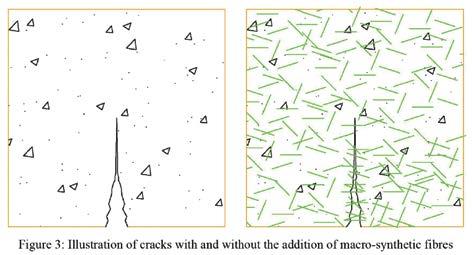
• Precast, paving and flooring works • High deformation sprayed concrete works (i.e. tunnel linings) • Railway Trackslab
Research recently conducted highlighted the benefits of BarChip fibres, namely BarChip 48 and BarChip MQ58 tested up to a fibre dosage of 2.0% by volume (i.e. approx. 18.2 kg/ m3) which were found to significantly improve the post-cracking capacity and failure mechanism of concrete elements [6, 7]. In fact, these benefits directly result from the addition of fibres which suppress and stabilise the propagation of cracks throughout the concrete matrix.
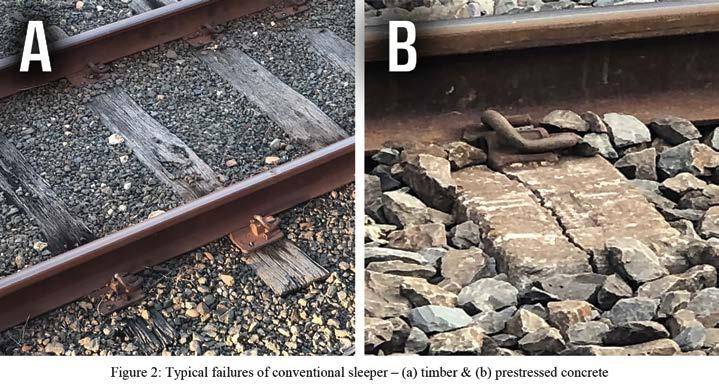
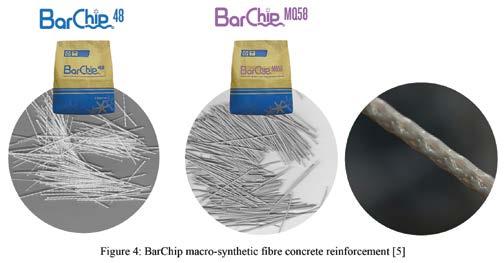
These studies also underlined the fact that such reinforcement system could be implemented in the railway prestressed concrete sleeper as a partial or complete substitute to the steel wires. That is to say, such inclusion of fibres at an optimum dosage could result in a lighter, cheaper, eco-friendly and corrosion-free concrete sleeper.
The prospects of incorporating such BarChip fibres in railway sleepers is encouraging for a sustainable future, yet challenging in achieving the same capacity as prestressing steel reinforcement. As such, research is currently being undertaken at Western Sydney University on macro-synthetic fibre reinforced concrete (MSFRC) sleeper to comprehensively understand the structural behaviour and any associated benefits of such BarChip fibre incorporation. The MSFRC sleeper is reinforced by the synthetic fibres distributed throughout the sleepers..
The benefits of BarChip fibre concrete reinforcement for sleeper applications is assessed to comply with Australian Standard AS1085.14-2012. The essential standard tests for sleepers are (1) Rail seat vertical load test, (2) Centre bending moment test and (3) Development length [8].
Based on the in-situ track and support conditions of the sleeper, it is most likely that the section will experience a positive moment at the rail seat and a negative moment at the centre. This means that the rail seat and centre sections of the sleeper are safety-critical and as such must be assessed prior to the implementation of BarChip macrosynthetic fibre reinforced concrete sleeper.
Understanding the contribution of BarChip fibres in the sleeper is key. Therefore, macro-synthetic fibre reinforcement was implemented at optimum dosage in the existing prestressed concrete sleeper to further evaluate any benefits as compared to an identical sleeper without the reinforcing BarChip fibres.
The potential implementation of such macro-synthetic fibre (i.e. BarChip) in railway sleeper as a partial or complete reinforcing alternative to steel is particularly in demand to allow for a cheaper, crack resistant, more environmentally friendly and corrosionfree concrete sleeper.
The first observation made in regards to the benefits of BarChip fibres is the cracking and failure mechanisms outlined in Figure 5.
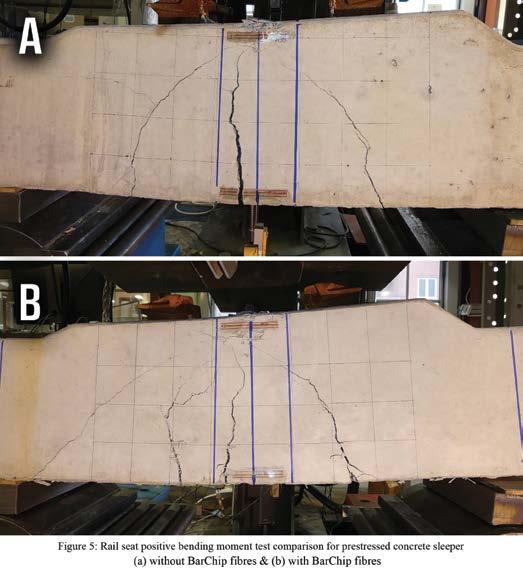
Although both sleepers (i.e. with & without BarChip fibres) experienced flexural-shear cracks in the rail seat positive moment test, the MSFRC one exhibited a better distribution of cracks with smaller crack widths. Similar crack widths reductions are observed through the centre negative bending moment test presented in Figure 6.
It can be justified that conventional prestressed concrete sleeper exhibited mostly a shear-compression failure with local crushing as demonstrated in Figure 6-(a). In comparison, the sleeper reinforced with prestressing steel and BarChip fibres experienced predominantly flexural cracks towards a shear-tension failure with reduced local crushing.
Other benefits of incorporating BarChip fibres in sleepers can be observed through the post-cracking residual capacity outlined in the load versus deflection graphs.
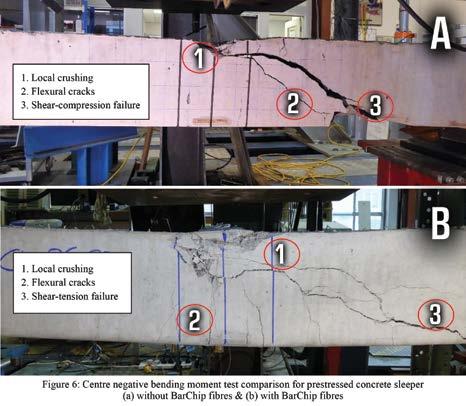
THE WORLDWIDE LEADER IN VIBRATION TECHNOLOGY
FLOW AIDS Any solution for your needs
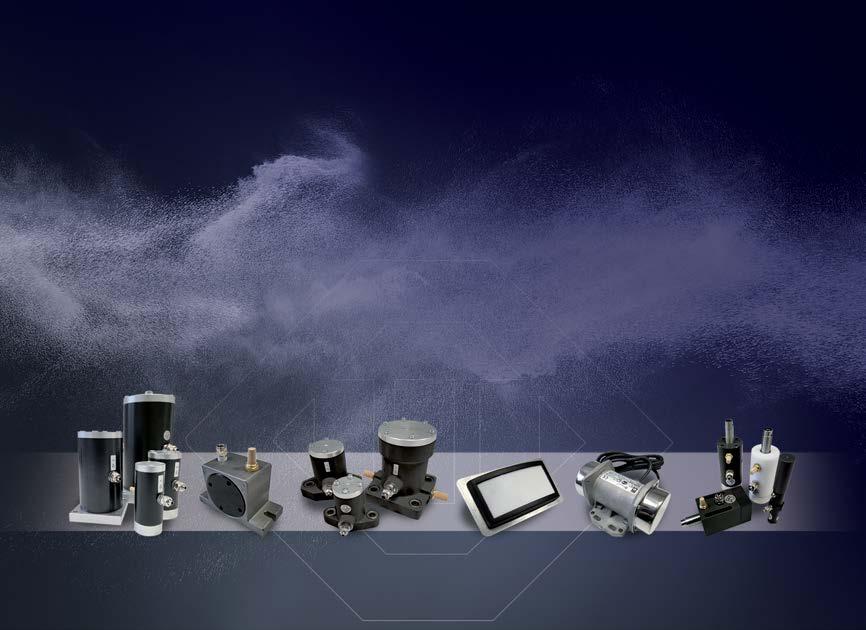
OLI is the world’s top selling manufacturer of electric and pneumatic vibrators. The high level of customer service, guaranteed by 18 trading subsidiaries worldwide, and long-lasting and performing products make us always ahead. The flow aids range of products offers any solution for your needs and helps you to increase the process efficiency and improve the plant safety.
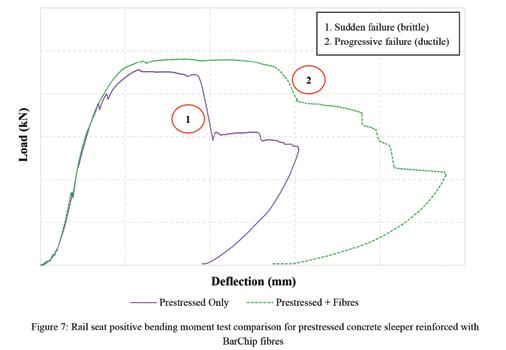
Figure 7 presents the improved serviceability behaviour of MSFRC sleeper in comparison to the conventional one although the presence of fibres insignificantly affects the ultimate load capacity. In other words, the BarChip reinforced sleeper was structurally sound up to larger deformations characteristically related to the additional ductility induced through the fibre bridging of cracks.
Shortly after the peak load, the conventional prestressed sleeper (i.e. no fibres) experienced a substantial drop in load corresponding to the sudden failure (i.e. brittle) in the bottom layer of prestressing tendons.
Comparatively, the MSFRC sleeper did not exhibited such drastic reduction in capacity through the presence of fibre assisting in the distribution of stresses across the section. As such, the sleeper incorporating fibres displayed a much slower progressive failure mechanism, a property desired in safety-critical railway track component.
Similarly, the centre negative bending moment test (Figure 8) highlighted the serviceability benefits of implementing BarChip fibres in railway sleeper. Indeed, the addition of fibres improved the failure mechanism towards a more ductile fracture with on average a 53% difference in deflection once the failure point is reached.
Such observations from the rail seat and centre tests demonstrate the potential benefits of BarChip macrosynthetic fibre reinforcement in terms of structural stability, serviceability and reduced maintenance (i.e. crack control) for sleeper applications. Further study is required to assess any potential reduction in the number of prestressing tendons while adding BarChip fibres as an ecofriendly alternative reinforcement method.
References
1.
2.
3.
4.
5.
6.
7.
8.
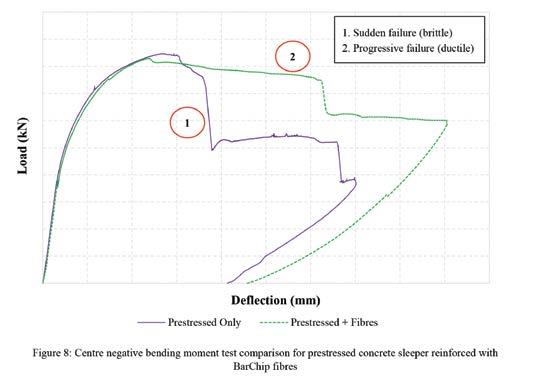
Deloitte, Value of Rail: The contribution of rail in Australia. 2017: A report commissioned by the Australasian Railway Association (ARA).
Sharma, R.C., et al., Modernization of Railway Track with Composite Sleepers. International Journal of Vehicle Structures & Systems, 2017. 9(5): p. 321-329.
Hameed, A.S. and A.P. Shashikala, Suitability of rubber concrete for railway sleepers. Perspectives in Science, 2016. 8: p. 32-35.
Silva, É.A., et al., Comparison of structural design methods for railway composites and plastic sleepers and bearers. Australian Journal of Structural Engineering, 2017. 18(3): p. 160-177.
BarChip. 2018 20 October 2018]; Available from: https:// barchip.com/product/.
Camille, C., et al. Mechanical Properties of MacroSynthetic Fibre Reinforced Concrete under Static loading for Railway Transoms Application. in 9th Australian Small Bridges Conference. 2019. Queensland, Australia.
Camille, C., et al. Evaluation of Macro-Synthetic Fibre Reinforced Concrete as a Sustainable Alternative for Railway Sleepers. in CIGOS 2019, Innovation for Sustainable Infrastructure, Proceedings of the 5th International Conference on Geotechnics, Civil Engineering Works and Structures. 2020. Hanoi, Vietnam: Springer Singapore.
Standard Australia Online, Railway Track Materials - Part 14: Prestressed concrete sleepers, AS1085:14:2012. 2012: SAI Global database.










